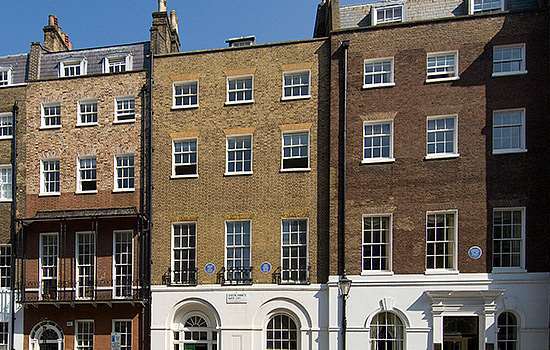The First Plaques
The idea of a commemorative plaque scheme was first put to the House of Commons by William Ewart MP in 1863. Three years later the Society of Arts (later the Royal Society of Arts) took the scheme on. It erected two plaques in 1867. The first commemorated the poet Lord Byron at his birthplace, 24 Holles Street, Cavendish Square, in 1867, but this house was demolished in 1889. This makes the plaque to Napoleon III on King Street, Westminster, also erected in 1867, the earliest to survive.
In the 35 years that the Society of Arts managed the scheme, it put up 35 plaques. Fewer than half of these survive, including those to John Keats, William Makepeace Thackeray and Edmund Burke.
Read more about blue plaque designs'Houses of Historical Interest'
At the turn of the 20th century, London County Council (LCC) took over the scheme and formalised the selection criteria. It became known as the ‘Indication of Houses of Historical Interest in London’, a name that lasted until the Second World War.
The LCC’s first plaque commemorated the historian Thomas Babington Macaulay in 1903. Another early LCC plaque is Charles Dickens’s in Doughty Street, which pre-dated the opening of his house as the Dickens Museum – and probably helped to preserve it.
The LCC experimented with the plaque design, trying different colours and decorative schemes, but by 1921 blue ceramic plaques had become standard. In 1938 the modern, simplified blue plaque was designed by an unnamed student at the Central School of Arts and Crafts, who was paid just four guineas.
The council put up an average of eight plaques each year until 1914. Despite the suspension of the scheme during both world wars, plaques continued to be unveiled at a regular pace. By 1965, when the LCC was abolished, it had been responsible for creating nearly 250.
The Scheme Expands
The LCC’s successor, the Greater London Council (GLC), not only broadened the range of people commemorated but covered a wider area. It unveiled plaques in uncharted territory such as Richmond, Croydon and Redbridge.
Between 1966 and 1985, when the GLC was abolished, it put up 262 plaques, commemorating figures such as Sylvia Pankhurst, campaigner for women's rights, Samuel Coleridge-Taylor, composer of The Song of Hiawatha, and Mary Seacole, the Jamaican nurse and heroine of the Crimean War.
Events at historical buildings were also marked by the GLC. One example was the former hayloft in Paddington where the Cato Street Conspiracy to assassinate Prime Minister Lord Liverpool and his entire cabinet was hatched in 1820.
In 1984 artisan ceramicists Frank and Sue Ashworth of London Plaques were appointed to make blue plaques, and they have been doing so ever since.
Blue Plaques and English Heritage
English Heritage took over the scheme in 1986 and has run it along similar lines to its predecessors ever since. The first plaque it erected, in that year, commemorated the painter Oskar Kokoschka at Eyre Court on the Finchley Road. Since then English Heritage has put up over 360 plaques, bringing the total across London to more than 900. A Blue Plaques Panel advises on the selection of individuals and brings a range of expertise to each case.
English Heritage continues to broaden the coverage of the scheme, both geographically – there are now plaques in all but two of London’s boroughs – and in the people being recognised. Recent figures commemorated have ranged from the football manager Herbert Chapman to Dame Maud McCarthy – a pioneering nurse in the First World War – and from Alan Turing to the guitarist and songwriter Jimi Hendrix.
In 2013–14 government cuts threatened the scheme, but the future of the blue plaques was secured by generous private donations. English Heritage became a charity in April 2015 and continues to manage the blue plaques scheme. An exciting programme of shortlisted figures, a continuous stream of new suggestions, and enthusiastic support from fundraising and the general public, all mean that the blue plaques scheme is in rude health, and recently celebrated its 150th anniversary.
-

The Changing Face of Blue Plaques
Find out how the design – and colour – of London’s blue plaques has changed over the years.
-

Top 10 Blue Plaque Facts
Blue plaques provide an intriguing glimpse into London’s past. Discover some fascinating and little-known facts about them.
-

Find a Blue Plaque
Discover who has been commemorated by one of the blue plaques on buildings across London.
